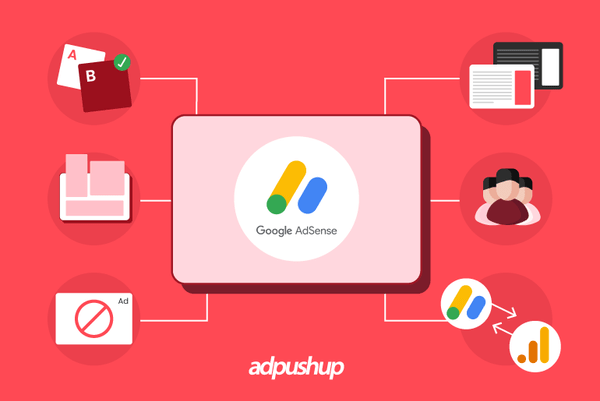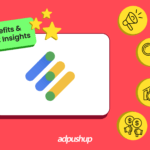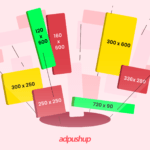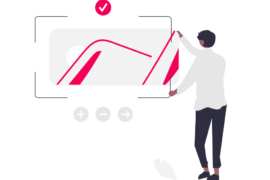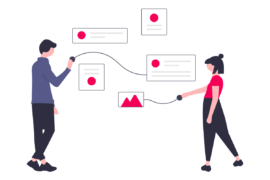Supercharge your Google AdSense revenue with expert strategies and proven techniques to maximize your earnings. Here’s all you need to know.
For many publishers, Google Adsense is a go-to source for monetizing content and earning money. However, simply implementing AdSense on your website is not sufficient to maximize your Google AdSense revenue.
AdSense boasts an impressive customer base of 2 million publishers and annually disburses over $10 billion to its esteemed publishers. However, simply gaining approval is not enough; you must possess a certain finesse to maximize its potential truly.
Achieving AdSense approval is an accomplishment, but ensuring that your website is optimized to its fullest potential is a different ball game altogether.
In this blog, we will take a look at how you can generate the most possible Google Adsense revenue, its benefits, and more.
How Much Google Adsense Revenue Can You Earn?
The question varies from publisher to publisher. In general, AdSense earnings per 1000 visitors is roughly about $0.2 – $2.5 per 1,000 views.
The AdSense program offers varying amounts based on the industry or adsense niche you focus on when creating content. Different industries attract different advertisers, which can impact the CPC rates and ultimately affect your AdSense income.
To find out your potential Google Adsense earnings potential, you would need to experiment and gather data on your own you need to try it on your own.
How to Calculate Your Google Adsense Revenue?
To find out your potential Google Adsense revenue, you can either calculate it manually or easily use our Adsense Revenue calculator. All you need is traffic numbers, CTR, and CPC.
Here’s the formula to calculate it.
AdSense Income = (Traffic x CTR x CPC) / 100
Multiply your traffic by your CTR, then multiply the result by your CPC. Finally, divide the value by 100.
If you want to eliminate the hard work, and instantly calculate your adsense revenue, use our adsense earnings calculator.
Top 16 Tips to Increase Your Google Adsense Revenue
One of the most common questions we often encounter is, ” How can I earn money with Google AdSense?” Here are a few Google AdSense revenue tips that will help you optimize your website for both higher revenue and an enhanced user experience.
1. A/B test Your Ad Units

The first tip in the list to help you increase AdSense revenue is A/B testing.
Experimenting allows you to compare one variation of ad settings to another and select the one that performs best, which is exactly what A/B testing for Publishers is designed for.
You can compare the performance of text-only ad units to ad units that have both text and display enabled, or analyze the effect of changing the color of ad text on ad performance, or determine the impact on your revenue by serving ads in the sensitive and/or general categories.
Although you need to be a little tech-savvy to navigate your way through the entire process of creating, experimenting, and monitoring your experiment, and finally choosing the winner—it’s all well worth the effort.
(Note: If you’re looking for a smarter, automated solution for this, you can try our AI-powered AB Testing solution, which automatically creates multiple variations of the ad for you and then selects the combination that can perform the best for your website).
2. Use Multiple Ad Units to Maximize Conversion
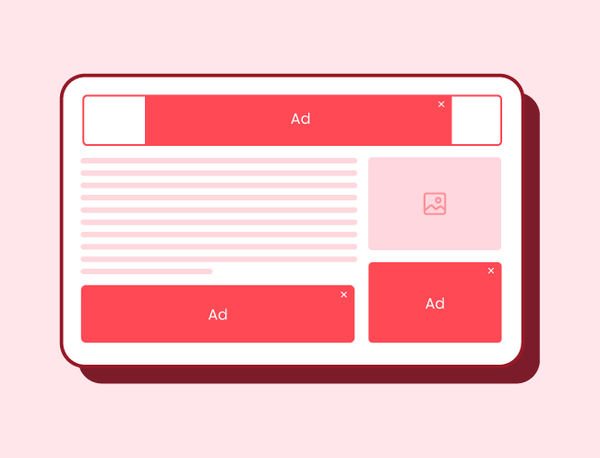
The second tip to increase Adsense revenue is to use multiple ad units. A simple way to bump up your AdSense click rate and revenue is to place ad units of more than one type (AdSense for content, link, and search) and in different sizes on your pages.
This way, your users will be served more ads from Google’s large ad inventory, increasing the probability that they will click on one of them.
Make sure that the best-located ad on your web page shows up first in your HTML code. This will ensure that your most visible ad real estate is taken by ads that place the highest in the auction—increasing your revenue.
And remember to adhere to the AdSense maximum ad policy, which is up to three AdSense for content units, up to three link units, and up to two search units on each page, to avoid having your account banned.
3. Limit the Number of Ads Above the Fold

In web design terminology, “above the fold” refers to the portions of a web page that are visible without scrolling. When too many ad units are placed above the fold, users get turned off because finding the content that they came in for gets difficult, and the tendency to exit the page increases. As a result of this, Google has penalized such pages. Here’s an excerpt from the Google Webmaster Central blog:
“As we’ve mentioned previously, we’ve heard complaints from users that if they click on a result and it’s difficult to find the actual content, they aren’t happy with the experience. Rather than scrolling down the page past a slew of ads, users want to see content right away. So sites that don’t have much content “above-the-fold” can be affected by this change. If you click on a website and the part of the website you see first either doesn’t have a lot of visible content above-the-fold or dedicates a large fraction of the site’s initial screen real estate to ads, that’s not a very good user experience. Such sites may not rank as highly going forward.
4. Optimize the Color Impact of Text Ad Units
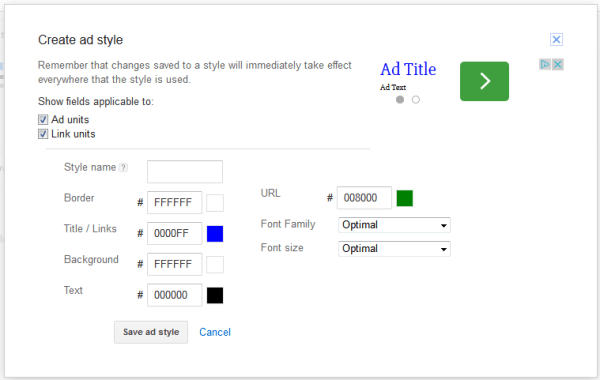
Experimenting with the colour of text ad units is essential to increasing their visibility. An ad style that works on a light website theme may look too bright and distracting on a darker one, turning users away not only from the ad but from the web page.
For the most unobtrusive user experience, match the background and border color of the ad unit to the background of the page where the ad will be placed.
For a more distinct ad, match the background and border colors to your website, but don’t match them exactly to where the ads are placed. Try out different styles and measure ad performance over time to settle on the best-performing format.
5. Create and Implement Responsive Ads
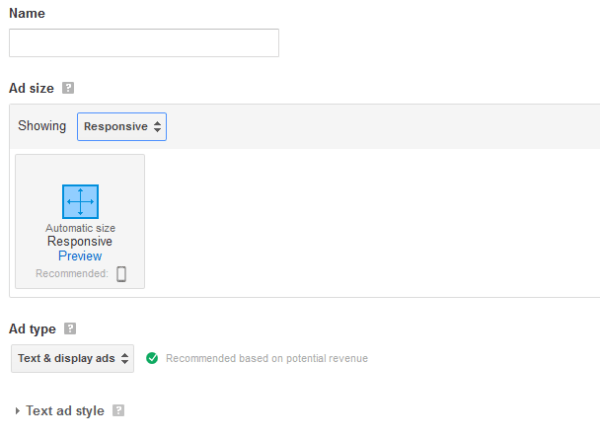
This ties into a larger point of implementing a responsive design on your website (which is something you really need to do if you’re running a website in 2015). Wikipedia explains responsive design as follows:
“Responsive web design (RWD) is an approach to web design aimed at crafting sites to provide an optimal viewing experience—easy reading and navigation with a minimum of resizing, mobile phones).”
Last year, Comscore reported that mobile platforms — smartphones and tablets — combined account for 60% of total digital media time spent, up from 50% a year ago. If your website is not optimized for these devices, you’re missing out on a big opportunity to capture this audience.
So what does this have to do with AdSense, you ask? Well, AdSense plays well with responsive design and allows you to generate codes for responsive ad units, which automatically resize themselves to offer the best viewing experience to the mobile audience. Do this now because that 60% is a number that’s only going to go north.
6. Link your AdSense and Analytics accounts
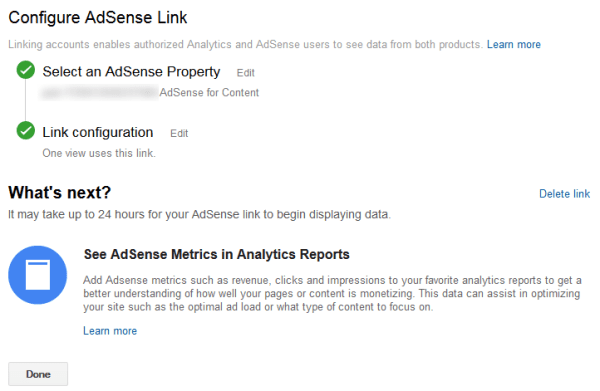
Linking your AdSense and Google Analytics accounts gives you access to AdSense metrics such as revenue, clicks, and impressions, which you can add to your favorite analytics reports to get a better understanding of how well your pages or content is monetizing.
This data can assist in optimizing your site such as the optimal ad load or what type of content to focus on.
Once you’ve linked your properties, you can use insights from Analytics to refine and optimize your AdSense ad units, improving the overall performance of your website.
7. Keep your Design & Content User-focused
In the mad race to increase Google AdSense revenue, it’s easy to lose sight of the real goal of why your website or business exists in the first place—to provide value to users.
Use a judicial mix of ads and content so that users are not overwhelmed by the former. Sometimes, ads are placed randomly on the web page and in between content without any thought to usability or aesthetics.
Even Google says that to get the most out of your account, you should first consider the user and then think about anything else. Doing it the other way around is like putting the horse before the cart; it’s never going to work.
8. Publish High-Quality Content on a Regular Basis
This is the big one for increasing your Google Adsense revenue. When it comes to AdSense earnings, content is the king. Adding more content, like blogs and articles, to your website helps increase its visibility.
Simply put: No traffic, no money; more traffic, more money.
But this is always easier said than done. It has always helped publishers to post content about a topic that the audience is interested in and content that has some level of expertise in it.
Google’s algorithm rewards websites that publish content regularly with a higher ranking and, consequently, higher traffic, so make sure your publishing is more predictable than erratic.
Finally, going the extra mile to optimize your content for search engines can yield great results in terms of organic traffic, especially in the long run, and this will lead to a higher Google Adsense revenue as well.
9. Make the Most of AdSense Filters
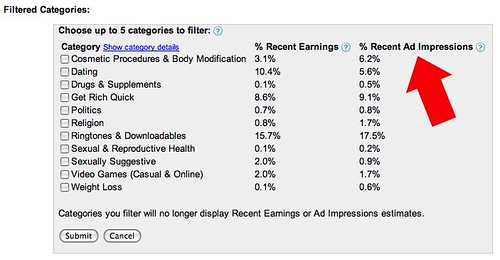
AdSense filters might not directly increase your revenue, but they’re a valuable tool for ensuring that the ads on your site align with your content. By filtering out irrelevant or conflicting ads, you can create a more cohesive and engaging experience for your visitors. However, it’s important to strike a balance. Over-filtering can limit the variety of ads shown, which could negatively impact your earnings. Use filters wisely to maintain both relevance and revenue.
This takes us to our next tip, which entails why you should cautiously use the blocking filters.
10. Go Easy with the Blocking and filtering
Each ad that you block by URL will be one more ad that won’t be bidding for space on your website in the auction—effectively reducing the earning potential of that ad space.
Furthermore, advertisers whose ads you block may decide that they don’t want to advertise with you in the future. The same thing happens when you filter out entire categories but on a larger scale. Don’t block ads unless it’s absolutely necessary.
11. Keep Yourself Updated
Lastly, in an effort to increase your Google AdSense revenue, don’t forget the basics, and that’s sticking to the new trends as well. Google’s help center has this brilliant AdSense optimization overview that you could look at and take ideas from to get more mileage out of your AdSense account.
12. Optimize Ad Placement
One of the primary things you need to focus on while boosting your revenue per thousand impressions (RPM), is ad placement optimization. With a handful of effective ad placement strategies, you can simply enhance the AdSense RPM.
As the term suggests, you need to place the ads at the right places on the webpage so that they can capture visitor’s attention with quick impact. Some of the suggested places are on the right or left of the page, near the bottom of the screen, in between content, and besides engaging elements.
However, make sure that the ads are not placed right at the top as they might get easily ignored by the user. In addition to keeping your focus on viewability, you must make sure that the appearing ads do not harm the user’s experience.
13. Focus on High Paying Keywords
Keywords serve as the cornerstone of RPM, anchoring its entire framework and ensuring everything stays aligned and effective. However, some of the keywords have a higher potential for receiving clicks and being searched. Advertisers demand for such keywords, and focusing on them will eventually boost the RPM.
To find the high-demand keywords, you can use keyword research tools like Google Keyword Planner and SEMRush, analyze the competitors to check what keywords they’re using, explore other related niches, and incorporate them into your writing.
14. Choose the Right Ad Format
Ad format has to play a vital role in the overall user experience and generating revenue. So, choosing the best-suited ad format will not only offer better visibility and engagement but also retain positive feedback on the user’s experience.
To choose the best high-performing ad formats, you need to monitor which ads have the highest CTR, which ads blend perfectly with the content on the webpage, which ads have uniform visibility on every platform, and which ads receive positive feedback from the users.
15. Increase Website Traffic
There’s no point in working on the ads if you don’t have a significant number of visitors to your site. So, to boost traffic organically, the only thing that can help you is Google itself. You need to publish content according to Google’s Update, which mostly emphasizes creating content that directly addresses user queries, as algorithms reward genuine value addition to the user experience. Apart from that, it’s crucial to optimize your site for mobile users, as Google now uses the mobile version for ranking and indexing.
Moreover, you must optimize the content for Google Discover, diversify your content across platforms to engage a broader audience, and strategically share content on favored social platforms to enhance exposure and AdSense RPM.
Furthermore, publishers can also choose to go with Adsense Arbitrage. However, if an AdSense account experiences a significant amount of bot or fake traffic, resulting in invalid clicks on ads, it risks suspension.
16. Reduce The Number of Ads Above The Fold
Above the fold is the section of the page, which appears first to the user and is visible until they scroll down. Hence, it is obvious that this position is much more expensive and desired by advertisers to display their ads.
Also, after understanding the importance of ads above the fold, many publishers place numerous ads there and end up creating chaos there. So, reducing the number of ads above the fold can be an extremely useful method to increase Google AdSense revenue.
Now let’s have a look at some of the benefits of using Google Adsense.
How does Google AdSense Help generate Revenue for publishers?
Largest Search Database
When it comes to the benefits of utilizing AdSense, one remarkable advantage stands out: gaining access to the largest search database in the world. With an astonishing number of over 50 billion indexed web pages, the possibilities are truly limitless.
Moreover, nearly 85% of internet users prefer Google search. This statistic speaks volumes about the popularity and trustworthiness of Google as a search engine.
By leveraging AdSense, you tap into this immense user base that love Google search. This translates to increased visibility and exposure for your content, products, or services.
Global Advertiser Reach
With Google’s extensive network of advertisers, publishers have access to a wide range of advertisers from various industries and geographic locations. This increases the chances of finding relevant ads for your audience.
Lucrative Revenue Potential
AdSense offers a revenue-sharing model where publishers earn a portion of the ad revenue generated from their website. According to Google, publishers receive 68% of the revenue, while Google keeps 32%.
Contextual Advertising
To analyze the page’s content, AdSense use contextual targeting. It then display ads that are highly relevant to the content of your website. it delivers targeted ads that align with users’ interests, increasing the likelihood of clicks and higher earnings.
Mobile Optimization
With the number of mobile users projected to reach 7.49 billion by 2025, the focus on mobile ad formats will increase. Thus, Adsense offers mobile-optimized ad formats, ensuring that your ads look great on smartphones and tablets. This enables publishers to tap into the growing mobile advertising market and monetize their mobile traffic effectively.
User-Friendly Interface
AdSense provides a user-friendly interface that allows publishers to easily manage their ad settings, track performance, and access detailed reports. This empowers publishers to optimize their ad placements and make informed decisions to maximize revenue.
Now you must be wondering how and when Google Adsense pays, let’s have a look.
Google AdSense Revenue Calculator
When and How is Google Adsense Revenue Paid?
Google AdSense operates on a monthly payment cycle. At the end of each month, AdSense calculates your income based on the clicks and impressions generated by the ads on your website. However, before finalizing the payment, AdSense conducts a thorough review to ensure the validity of the clicks and impressions.
The review process typically takes a few weeks and aims to identify any false or fraudulent activity that may have occurred. This process is usually completed by the 20th of the following month.
Once the review is finished and your earnings have been validated, Google AdSense initiates the payment process. Payments are generally sent during the last week of the month following the one in which the earnings were accrued. For example, if you earned income in January, the payment for that month would be sent in the last week of February.
How Much Commission Does Google Adsense Keep?
Google AdSense charges advertisers for clicks on their ads. Publishers receive 68% of the click revenue for regular ads and 51% for AdSense for search. Payments are made monthly when earnings reach $100 or more. Amounts below $100 roll over to the next month. Payment options include a direct transfer or a check.
You can also head to Google’s Payment FAQs for more information.
Final Words
From optimizing ad placements and formats to delivering targeted content and engaging with your audience, taking proactive steps can have a substantial impact on your Google AdSense revenue. Stay dedicated, analyze data, and continue to refine your approach to unlock the full potential of your monetization efforts.
FAQs on Google Adsense Revenue
Google AdSense pays $0.50 to $2 per 1000 page views on average, but the exact amount can vary significantly depending on several factors.
The amount of money you can expect to earn from Google AdSense with 50,000 page views depends on the average CPC of the ads, CTR, and location of your visitors. For example, the average CPC for job ads is $1-5. With an average CPC of $2 and a CTR of 2%, you could earn around $200 per month.
AdSense typically pays between $1,000 to $10,000 for 1 million views, depending on niche, audience location, and advertiser demand.

Deepak has a keen eye for detail and a deep understanding of the ad tech landscape. Whether it’s through in-depth articles, thought-provoking insights, or compelling storytelling, he’s dedicated to helping people navigate the complex world of ad tech with the simplicity of his words.
